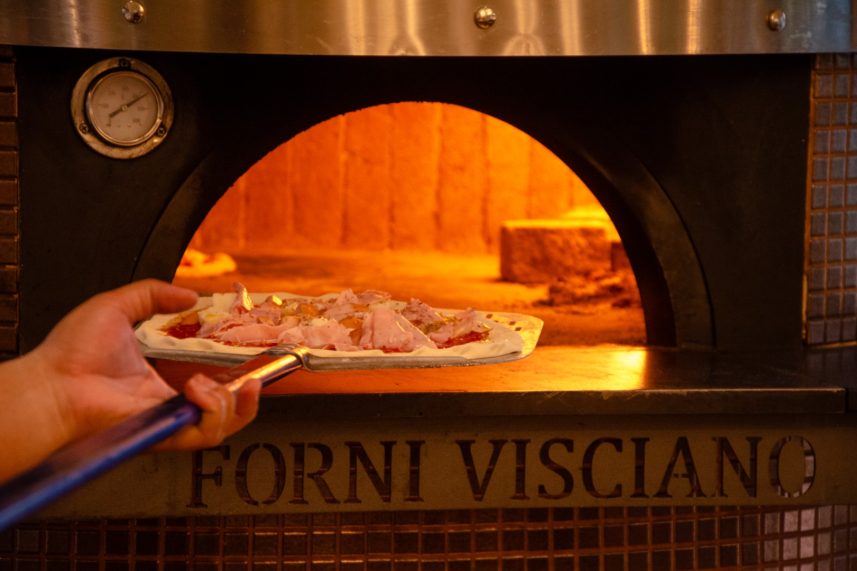
The Neapolitan Pizza Journey: From Mount Vesuvius to Your Plate
In the bustling heart of Canal Village, Laguna Phuket, an extraordinary culinary journey unfolds daily—one that bridges continents and centuries. At Pizza Fire, the ancient art of Neapolitan pizza-making lives on, connecting diners to a tradition that began in the shadow of Mount Vesuvius and now finds its perfect expression on Thailand’s shores.
The Sacred Fire of Naples
The story begins with fire—not just any fire, but the specific, almost mystical heat that has defined Neapolitan pizza for over three centuries. Our magnificent brick oven stands as a testament to this enduring tradition, having made its own remarkable journey from the cobbled streets of Naples to the tropical paradise of Phuket. Constructed using time-honoured techniques, this authentic masterpiece incorporates volcanic sand from Vesuvius itself—the very mountain that once buried Pompeii but whose fertile slopes have nurtured Italy’s finest tomatoes for generations.
The oven’s construction follows ancient specifications: brick and mortar foundations support a distinctive “biscotto” baking stone floor, all encased in a striking copper-coloured exterior. This isn’t merely cooking equipment; it’s a piece of living history that maintains the blistering temperatures of 900-1000 degrees Fahrenheit necessary for authentic Neapolitan pizza.
The Art of the Pizzaiuolo
In Naples, the pizza chef holds an almost sacred position. Known as a pizzaiuolo, these artisans undergo years of training to master their craft. The tradition demands more than technical skill—it requires passion, intuition, and an understanding of how dough responds to touch, how fire behaves, and how ingredients transform under extreme heat.
At Pizza Fire, we honour this tradition through meticulous adherence to authentic techniques. Each pizza begins as a carefully prepared dough, hand-stretched rather than rolled, preserving the delicate air bubbles that create the characteristic texture. The pizzaiuolo’s experienced hands work quickly but deliberately, shaping each base with movements refined over centuries of tradition.
Ninety Seconds of Transformation
The magic happens in precisely 90 seconds. At 900 degrees, the intense heat creates a culinary alchemy that cannot be replicated in conventional ovens. The extreme temperature causes the dough to puff dramatically, creating the signature soft cornicione—the puffy outer crust that’s crispy on the outside yet tender within. Simultaneously, the centre remains thin and delicately soft, sometimes appearing almost wet—a characteristic that often surprises newcomers to authentic Neapolitan pizza.
This rapid cooking process seals in flavours whilst creating textural contrasts impossible to achieve through slower methods. The wood fire imparts subtle smoky notes, whilst the volcanic stone floor provides the intense, even heat that crisps the bottom whilst keeping the toppings fresh and vibrant.
The Imperfection of Perfection
Unlike mass-produced pizzas, each Neapolitan pizza emerges as a unique creation. The hand-stretching process ensures slight irregularities—no two pizzas are perfectly round. These variations aren’t flaws; they’re signatures of authentic craftsmanship. Each pizza tells the story of its creation, bearing the subtle fingerprints of its maker and the organic nature of working with living dough.
The approximately 12-inch diameter provides the perfect canvas for showcasing premium ingredients. San Marzano tomatoes, cultivated in the volcanic soil near Naples, provide the sweet, intense flavour that forms the foundation of our red pizzas. Buffalo mozzarella from Campania offers creamy richness, whilst fresh basil adds aromatic brightness.
From Tradition to Table
The journey from Mount Vesuvius to your plate encompasses more than geography—it represents a commitment to preserving culinary heritage in an increasingly homogenised world. Every element, from the volcanic sand in our oven to the traditional eating methods we encourage, connects diners to centuries of Italian culture.
Neapolitans traditionally consume their pizza with knife and fork or folded “libretto” style—like closing a book. These customs reflect the pizza’s origins as street food for working people, designed for practical consumption whilst maintaining dignity and tradition.
A Living Tradition
At Pizza Fire, we’re not merely serving food; we’re continuing a story that began centuries ago in southern Italy. Our brick oven, shipped across oceans, now writes new chapters of this ancient tale beneath Phuket’s tropical skies. Each pizza that emerges from our wood-fired oven carries forward the legacy of countless pizzaiuoli who perfected their craft in Naples’ narrow streets.
This extraordinary journey—from volcanic slopes to tropical paradise—demonstrates how authentic traditions transcend borders, bringing people together through shared appreciation for craftsmanship, quality, and the simple pleasure of exceptional food prepared with passion and respect for heritage.

There are no comments